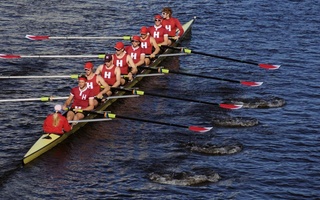With just four teams left in the 2010 NCAA men’s basketball tournament, leading into this weekend’s festivities many seniors are preparing for their last shot at glory—but they are not alone. One of the newest and most depressing trends in college basketball has been the “one and done,” which no longer means a team losing their first game of a tournament, but rather a star player leaving college after his freshman season. Although this pattern is recent, the list of players that have already successfully made this jump include high-profile professionals such as Kevin Durant, Carmelo Anthony, and Greg Oden.
The catalyst for the number of players jumping ship after freshman year was a 2006 change in NBA eligibility rules that prevents players from entering the draft until a full year after they graduate high school. Although the outcome of this decision was nebulous to coaches and players alike at the time of its announcement, enough time has passed now to gauge the rule’s repercussions. For the prodigious high school players that used to go directly to the NBA, like Kobe Bryant and LeBron James, the route to the pros now involves an obligatory one-year stop in college. Superficially it would seem that some time in school is better than none at all. However, the “academic” trip these players take for one year devalues the traditional four-year American university education even more than them skipping college entirely would.
Presumably the NCAA, the governing body of U.S. intercollegiate athletics, prides itself on the emphasis of student in the student-athlete, with advertising campaigns, graduation rate statistics, and online guides. However, in practicality they go directly against those practices. Widely seen Final Four tournament television coverage is frequently given to stars who will be packing their bags after just one season. This spotlight makes it blaringly clear how little value is put on being a student, when in these cases only one quarter of the college commitment is finished. These “students” send the message to high-schoolers that treating college as a one-year stepping stone to a pro sports team is okay. This trend reduces high-profile student-athletes to athletes alone; the college jersey might as well reading “pre-professional.”
Of course these cases are still far more the exception than the rule; seniors this year like Jon Scheyer of Duke and Willie Veasley of Butler represent the many four-year students playing at an extremely high level while earning their degrees. The danger here is not necessarily the number of players opting out of college after one season but rather the cultural normalcy that comes along with it.
The question of how to stymie this movement is complicated. Although colleges are in part to blame for accepting athletic prodigies with the knowledge that they will leave after one year—taking them for athletic success and not academic potential—they are not the root of this issue. As backward as it may sound, the NBA should re-allow players to enter the league directly from high school. Rather than letting the small number of high-profile players publicly act as college students for a year and thus set an example to young fans that college is a one-year stop, let them go directly to the professional careers that lie ahead of them already. The student-athlete has a rich history in the country and is still actualized for thousands. It’s crucial that that remain the case for college’s stars as well as the regulars. Let’s hope the freshmen this weekend who don’t lift the trophy get three more chances at winning it all.
Marcel E. Moran ’11, a former Crimson associate editorial editor, is a human evolutionary biology concentrator in Eliot House.
Read more in Opinion
Breaking the SilenceRecommended Articles
-
GADFLYJOHN GOTTI ’09 A canary informs us that the family of departed mobster John Gotti is confident the Teflon Don’s
-
Like Facebook, But More ExploitativeIt is a truth universally acknowledged that one’s Facebook.com profile is closely correlated to one’s success in the sack. Attractive
-
 Radix Malorum Est (Ok)Cupiditas
Radix Malorum Est (Ok)Cupiditas -
 Hate It: Facebook Timeline
Hate It: Facebook Timeline -
 763 Men of Harvard Want Hotness Today
763 Men of Harvard Want Hotness Today -
Harvard Among Schools Providing Unclear Financial Aid Instructions, Congressional Committee AllegesHarvard, along with 110 other institutions of higher education, may be illegally misleading prospective students by providing unclear financial aid instructions, according to the House Committee on Oversight and Government Reform investigation.













